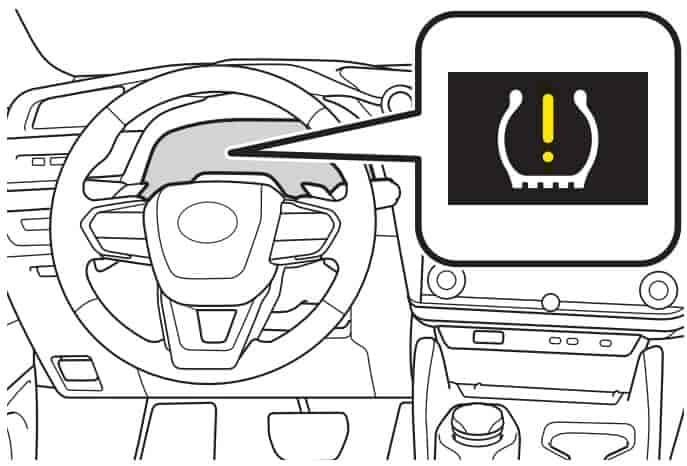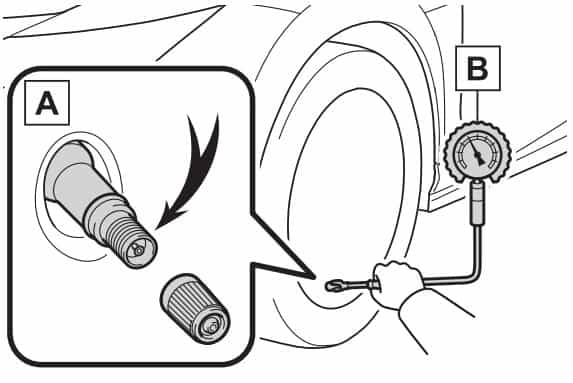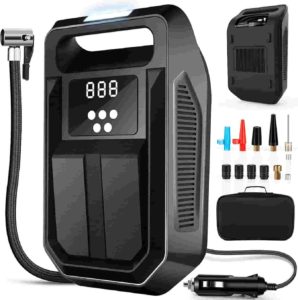Lexus RZ Tire Pressure Monitoring System
As a Lexus RZ owner, you’ve already made a commitment to quality, luxury, and technology. In this article, we delve into one specific piece of that technology – the Tire Pressure Monitoring System (TPMS). This sophisticated system is designed to provide real-time information about your vehicle’s tire pressure, alerting you when adjustments are needed. Understanding the details of the TPMS, such as how sensors work, the impact of weather on tire pressure, and why the TPMS light might illuminate, will equip you with the knowledge to maintain optimal tire performance. We’ll also guide you through essential procedures like how to check tire pressure, how to install new TPMS sensors, and how to reset the TPMS light. With this knowledge, you can ensure your Lexus RZ always delivers the most comfortable ride, with maximum EV range and the utmost safety. Let’s begin this journey by exploring how the Lexus RZ TPMS functions.
How Does the Lexus RZ TPMS Work?
The Tire Pressure Monitoring System (TPMS) in a Lexus RZ is a sophisticated system designed to monitor the air pressure inside the tires. The system is crucial for your safety as it alerts you when the tire pressure is too low.
Here’s a detailed explanation of how it works:
Sensors: Each wheel of your Lexus RZ is equipped with a tire pressure sensor, which is located inside the tire attached to the wheel. These sensors are designed to continuously measure the air pressure inside the tires.
Unique ID Codes: Each sensor has a unique ID code. When new tire pressure sensors are installed, such as when you replace a tire or use a different set of wheels (like a winter set), these new ID codes need to be registered to the tire pressure warning computer in your vehicle.
Data Transmission: The sensors transmit the tire pressure data wirelessly to the TPMS module in your vehicle. This data transmission happens regularly while the vehicle is in motion to ensure real-time monitoring of tire pressure.
Dashboard Indicator: If the system detects that the pressure in one or more of the tires is significantly below the recommended level, it triggers a warning light (a yellow exclamation mark inside a tire symbol) on your vehicle’s dashboard. This is an immediate signal for you to check your tire pressures.
Manual Settings: The system allows you to manually set the desired tire pressure levels via the vehicle’s center display. You can navigate through the settings by selecting “Vehicle Customize” -> “Tire Pressure”. You can also register the position of each wheel and adjust the tire inflation pressure through this interface.
Two Sets of ID Codes: The Lexus RZ’s TPMS is designed to allow two sets of ID codes, allowing you to easily switch between two sets of wheels (like a summer set and a winter set) without needing to re-register the sensors each time.
Alerts and Warnings: In addition to the low-pressure warning, the system will also alert you if it detects a malfunction in the TPMS itself, or if it cannot receive signals from one or more of the sensors, perhaps due to a sensor battery failure.
Understanding Tire Pressure
How to Check and Adjust Tire Pressure
Make sure the tires are cold. If your vehicle has been driven, wait at least three hours before checking the tire pressure.
Remove the valve cap from the tire.
Press the tip of the tire pressure gauge onto the valve and read the pressure.
If the tire pressure is below the recommended level, fill the tire with air until the recommended Psi is reached (38 psi). If the tire pressure is above the recommended pressure level, release air until it’s correct. (Press the metal stem in the center of the tire valve to let air out. You can use any object like a screwdriver to do this. Be gentle.)
After adjusting the tire pressure, don’t forget to put the valve caps back on to prevent leaks and keep dirt and moisture out.
Repeat this process for each tire, including the spare if applicable.
2023 Lexus RZ Tire Pressure
TIRE SIZE | FRONT PSI | REAR PSI |
235/60R18 | 38 | |
255/55R18 | 38 | |
235/50R20 | 38 | |
255/45R20 | 35 | |
SPARE | 60 | 60 |
What is "Cold" Tire Pressure and Why is it Important?
Cold tire pressure in the Lexus RZ refers to the air pressure in the tires when they are at ambient temperature. This is typically when the vehicle has been stationary for several hours or has been driven less than a mile at moderate speed. This pressure is considered ‘cold’ because the tires haven’t been heated up by driving, which can cause the air inside them to expand and the pressure to increase. Checking and adjusting your tire pressure when the tires are cold provides the most accurate measurement. This ensures optimal vehicle performance, EV range, and safety. The manufacturer’s recommended tire pressure settings are based on these cold tire conditions. Therefore, making adjustments when the tires are cold is the best practice as it aligns with these recommendations and helps prevent overinflation of the tires. The maximum inflation pressure, which is the highest level to which a tire may be inflated when cold, can be found on the tire’s sidewall.
Does Weather Affect Tire Pressure?
Weather conditions can significantly impact the air pressure in your Lexus RZ. As a rule of thumb, for every 10 degrees Fahrenheit change in air temperature, tire pressure will change about 2% or roughly 1 psi. In colder weather air contracts which can lead to a decrease in tire pressure. Conversely, in warmer weather air expands, causing an increase in tire pressure. This fluctuation can affect the vehicle’s handling and EV range and it may also lead to uneven tire wear. Therefore, it’s crucial to regularly check and adjust your tire pressure when there are significant changes in weather conditions.
TPMS Warning Signals and Safety Considerations
What Causes the Lexus RZ Tire Pressure Light to Come On?
Seasonal temperature changes: A drop in ambient temperature can cause tire pressure to decrease, triggering the warning light.
Tire puncture or leak: A sharp object or road debris like a nail or screw may puncture a tire, causing air loss which will of course activate the warning light.
Faulty tire pressure sensor: Damaged or malfunctioning sensors may provide inaccurate readings, resulting in a false alert. The only way to determine which sensor is faulty is to scan each sensor with a TPMS diagnostic tool.
Valve stem issues: A damaged or leaking valve stem can lead to gradual pressure loss and eventual activation of the tire pressure light. They make kits to replace the rubber gasket that usually goes bad.
Tire damage: Impact from potholes or hitting a curb can cause structural damage like tire bubbles, leading to pressure loss.
Recent tire rotation or replacement: If the tires have been recently rotated or replaced, the TPMS may need recalibration to avoid false alerts. Follow the tire rotation reset procedure after a tire rotation.
Wheel issues: Damaged, corroded, or cracked wheels can lead to air leaks and pressure loss. This is very common with low profile tires.
Altitude changes: Climbing or descending in elevation can affect tire air pressure and trigger the TPMS warning. An additional 1.5 Psi per Km above sea level is required.
Natural pressure loss: Tires lose air pressure over time due to temperature changes and permeation. Tire dry-rot will happen to tires that sit.
Electrical problems or software issues within the car’s TPMS system. Occasionally the system may have a software update from Lexus.
Snow Tires: If you have a separate pair of wheels for your snow tires, you can either transfer the sensors from your summer wheels or acquire an additional set of 4 sensors for the second pair of wheels. However, if you are using the same wheels for both sets of tires, there is no need to be concerned about this.
Dfgjdflkgjdlkg
Is it Safe to Drive the Lexus RZ With the Tire Light On?
We highly advise against driving your Lexus RZ when the tire pressure warning light is on. It’s essential to determine the issue that’s causing the light to illuminate. Could there be a nail or screw lodged in the tire? Might there be a bead seal leak? Is the tire losing air rapidly or gradually? Understanding the exact problem will help you decide if it’s safe to keep driving with the tire light on and for how long. This situation highlights the usefulness of keeping a portable tire inflator in your vehicle at all times.
What are the Affects of Driving the Lexus RZ With Underinflated Tires?
Improper tire inflation can lead to several issues, including:
Increased tire wear.
Uneven tire wear.
Reduced EV range
Deteriorated handling.
Risk of blowouts due to overheated tires.
Air leakage between the tire and wheel.
Potential for wheel deformation and/or tire damage.
Increased likelihood of tire damage while driving, due to road hazards, expansion joints, sharp edges on the road, and so on.
Resetting and Troubleshooting the TPMS
Lexus RZ Tire Pressure Light Reset Procedure
Adjust the tire inflation pressure of each tire to the appropriate level. Adjust the tire inflation pressure when the tires are cold.
Start the EV system. Note that the tire inflation pressure cannot be set while the vehicle is moving.
Select the Gear icon on the center display.
Choose “Vehicle customize“.
Select “Tire pressure“.
Choose “Set current air pressure“.
Click on “Continue“. The tire pressure warning light will slowly blink three times, and a message indicating that the tire inflation pressure is being set will be displayed on the multi-information display.
Lexus RZ Steps to Set the Tire Pressure to a Desired Pressure
Start the EV system. Please note that the tire inflation pressure cannot be set while the vehicle is moving.
Select the gear icon on the center display.
Choose “Vehicle customize“.
Select “Tire pressure“.
Choose “Set indicated air pressure“, then select the desired front and rear tire pressures.
Click on “OK“. The tire pressure warning light will slowly blink three times.
NOTE: This procedure is if you want to change the factory settings of tire pressure levels.
Lexus RZ Reset Procedure After a Tire Rotation
Follow this reset procedure after a tire rotation so that the Lexus RZ ECU knows the new location of each tire after being rotated.
Park the vehicle in a safe location, turn the power switch off, and wait for at least 15 minutes.
Start the EV system. Note that the wheel position registration procedure cannot be performed while the vehicle is in motion.
Select the gear icon on the center display
Choose “Vehicle customize“.
Select “Tire pressure“.
Choose “Tire rotation“.
Click on “Continue“. A message will appear on the multi-information display indicating that wheel position registration is in progress. The tire inflation pressure for each tire will be displayed as “—“, and the wheel position registration will commence.
Drive straight at a speed of approximately 25 mph (40 km/h) or more for about 10 to 30 minutes. Make occasional left and right turns. Once the wheel position registration is complete, a message will be displayed on the multi-information display indicating that the registration has been completed. The inflation pressure of each tire will also be displayed.
Please note that the wheel position registration process can be performed independently. However, depending on the driving conditions and environment, the registration process may take some time to complete.
When Should You Reset the Lexus RZ Tire Pressure System?
After tire rotation
After tire pressure adjustment
After tire or wheel replacement
After tire repair
Anytime a tire or wheel is removed and put back on the car
After a tire pressure sensor or valve is replaced or repaired
fgdfg
What Tools Do You Need to Reset the Lexus RZ TPMS?
The only tool you need to reset the Lexus RZ is a basic tire pressure gauge. All of the reset functions are built into the Lexus RZ. TPMS tools are only needed when the tire pressure system needs troubleshooting or diagnosing. For example if there is a faulty sensor that the Lexus RZ ECU is not recognizing you can use a TPMS diagnostic tool to determine which sensor is damaged or not working.
Troubleshooting the Lexus RZ Tire Pressure System
Why is the Tire Pressure Light Flashing?
Your Lexus RZ also has a separate warning light to alert you to potential issues with your tire pressure monitoring system (TPMS). It’s called the TPMS malfunction indicator. This warning light uses the same yellow exclamation point as the standard tire pressure warning light on the dashboard. If there is a problem with the TPMS, the light will flash for approximately 60 seconds before staying on. This sequence will occur every time you start your car until the issue is resolved. When your tire light is flashing, the system will not be able to accurately detect low air pressure. Essentially, a flashing tire pressure light usually indicates a problem with the Tire Pressure Monitoring System (TPMS) itself, rather than signaling an issue with the actual tire pressure.
What Causes the TPMS to Malfunction?
Tire pressure sensor battery depletion.
Using non-genuine Lexus wheels or tires.
Replacing a tire that doesn’t match the OEM size.
Proximity to a TV tower, power plant, gas station, radio station, large display, airport, or any other facility that emits strong radio waves or electrical noise.
Installing tire chains: The process of fitting chains onto the tires for the snow can lead to a disruption in the functioning of the TPMS.
Installation of thick window tint that interferes with radio wave signals.
Inflation of the tire pressure significantly above the recommended level.
If there is a lot of ice or snow on or around the tire valves.
If wheels without tire pressure sensors are installed on the car.
If the Lexus RZ receiver module/ECU does not recognize new tire pressure sensors installed.
Tire Leaks and Solutions
Identifying the Source of a Tire Leak
To pinpoint the origin of a tire leak, begin by checking the air pressure in each tire to identify the one that is underinflated. Ensure that the tire is inflated, as the subsequent steps won’t work effectively if the tire is entirely flat. Then, take a spray bottle filled with a mixture of soap and water (or Windex) and thoroughly spray the whole tire. Pay special attention to the bead (the area where the tire meets the wheel) and the valve stem. Ensure the entire tire is completely soaked. After letting it sit for a while, meticulously examine the tire for any tiny bubbles forming. If a leak is present and the soapy solution has been applied, the air escaping from the leak will create tiny bubbles at the leak site. Be patient and observe closely – if the tire is deflating, there’s a leak somewhere!
Are Tire Plugs Safe?
Yes! Tire plugs are a reliable solution based on extensive personal experience of repairing numerous tires. They serve as a dependable repair method for punctures located in the tire’s tread area. Tire plugs are engineered to be inserted directly into the puncture caused by objects like nails or screws, effectively sealing the hole and preventing air leakage. (Don’t forget to remove the object causing the puncture first.) Constructed from durable rubber-like materials, tire plugs are built to endure the challenging conditions inside the tire such as significant fluctuations in air pressure and temperature. If installed correctly, a tire plug can last for the entire lifespan of the tire without needing to be replaced. Lexus specifies that if the pressure falls below 19 Psi and the tire has been driven on for a certain duration, the tire cannot be repaired. It’s also important to remember that tire plugs are not appropriate for repairing the tire’s sidewall.
Are Tire Sealants Safe?
Tire sealants can serve as a temporary fix for a flat tire on your Lexus RZ during emergencies, but they aren’t designed for long-term use. It’s crucial to understand that these products could potentially damage your tire pressure sensors, as the sealant can obstruct or disrupt the sensor’s functionality. Additionally, tire sealants can inflict harm on the tire itself, rendering it irreparable or unfit for plugging or patching. Sealants can also disrupt the tire’s balance, resulting in driving vibrations. This is due to the fact that you’re essentially injecting a liquid into the tire. As a rule of thumb, it’s advisable to refrain from using tire sealants unless absolutely necessary. If you do resort to using a sealant, ensure you visit a tire repair shop at your earliest convenience for a proper repair!
Advanced Topics
How to Install New Tire Pressure Sensors
To begin, the wheel must be detached from the Lexus RZ, and then the tire has to be removed from the wheel to access the sensor. Typically, the old sensor is loosened at its base with a screw and taken out, followed by the valve stem being pulled out through the top of the wheel. With the old sensor removed, you can start installing the new one. Make sure that the new sensor is compatible with the Lexus RZ TPMS module. To install the new sensor, use a tire valve removal tool to pull the valve through the valve hole on the wheel. (It’s wise to take pictures of each new sensor’s ID code before installation, as these numbers may be needed later and will be hard to access once the tire is put back onto the wheel.) Once the new sensor is fixed and the tire is reattached to the wheel, the new sensor must be registered with the Lexus RZ’s Electronic Control Unit (ECU). This is known as the TPMS “relearning” process.
How to Register New Sensor ID Codes
Use this procedure if you install new sensors or use a second set of wheels. This feature enables you to register an additional wheel set, such as a set of winter tires.
Ensure that no wheels with tire pressure warning valves and transmitters installed are near the vehicle.
Park the vehicle in a safe place, turn the power switch off and wait for at least 15 minutes.
Start the EV system. The ID code registration procedure cannot be performed while the vehicle is moving.
Select the Gear icon on the center display.
Choose “Vehicle customize“.
Select “Tire pressure“.
Check if the desired wheel set (“Set 1″ or “Set 2“) is displayed. ID codes will be registered to the displayed wheel set. To change the wheel set to be registered, select the displayed set, and then select the wheel set you wish to register. If ID codes have already been registered for that wheel set, the tire pressure warning light will slowly blink three times, and a message indicating that change is occurring will be displayed on the multi-information display.
Select “New tire registration“.
Click on “Continue“. The tire pressure warning light will slowly blink three times, and a message indicating that ID code registration is being performed will be displayed on the multi-information display. Wheel set changing will be canceled and registration will begin. When registration is being performed, the tire pressure warning light will blink for approximately 1 minute then illuminate and “—” will be displayed for the inflation pressure of each tire on the multi-information display.
Drive straight at a speed of approximately 25 mph (40 km/h) or more for about 10 to 30 minutes. Make occasional left and right turns. Once the registration is complete, the tire pressure warning light will turn off and a message will be displayed on the multi-information display indicating that the registration has been completed.
Please note that if the tire pressure warning light does not blink three times when starting the ID code registration procedure, the procedure may not have started. In this case, perform the procedure again from the beginning.
Tire Pressure Sensor Batteries
Tire Pressure Monitoring System (TPMS) sensors in your Lexus RZ run on minuscule, yet remarkably efficient batteries. These batteries are integral to the sensor’s function, enabling continuous monitoring and wireless transmission of tire pressure data. However, they’re not user-replaceable, being sealed within the plastic sensor unit. Typically, these batteries boast a lifespan of 5 to 10 years, influenced by driving habits, mileage, and environmental conditions. Their longevity does not make them invincible, and over time they will inevitably deplete. When the battery life diminishes the sensor’s ability to send accurate real-time data to the TPMS module may be affected. Therefore, if your vehicle is in this age range and you start to notice intermittent TPMS warning lights or other tire pressure discrepancies, a sensor battery nearing its end could be the culprit. The battery itself cannot be replaced because it is part of the electronic board within the sensor, the entire sensor needs to be replaced.
TPMS Legal Considerations
Are TPMS Sensors Legally Required?
In many regions worldwide, including the United States and Europe, laws mandate the use of tire pressure monitoring system sensors in vehicles. The TREAD Act of 2000, enacted in the U.S., requires all vehicles manufactured after September 2007 to be equipped with a TPMS. This law is mainly directed at manufacturers, not drivers, with the goal of enhancing road safety by alerting drivers to significant changes in tire pressure. Similarly, European regulations implemented from November 2012 require all new passenger vehicles to have a TPMS, though they do not specify whether the system must be direct or indirect. The primary objective of these rules is to reduce accidents caused by tire failures.
Will my Lexus RZ Pass State Inspection With the Tire Pressure Light On?
Yes. In certain states, the tire pressure monitoring system is inspected during a vehicle’s safety examination, but the specific requirements can vary. For example, in New York, the tire pressure light is assessed as part of the inspection process, but it is not a cause for failure. In Texas, the TPMS is checked during the safety inspection but you will not be failed if it isn’t working correctly. I am personally a licensed New Jersey state inspector and in NJ having a functional TPMS in a passenger vehicle is not a requirement. If the tire pressure light is on the vehicle will still pass inspection. Commercial vehicles are a different story because they still require “safety inspections”. (commercial vehicles can be identified by their license plates)The lack of uniformity between states means it is recommended to check with your local Department of Motor Vehicles or other relevant state agencies for the most accurate and up-to-date information.
Conclusion
The Lexus RZ’s Tire Pressure Monitoring System (TPMS) is an innovative solution to a common issue that drivers face – maintaining optimal tire pressure. By leveraging state-of-the-art sensors, real-time data transmission, and straightforward dashboard indicators, the TPMS ensures a safer, more efficient, and comfortable drive. Although external factors such as weather changes or tire damage may affect tire pressure and trigger the TPMS light, understanding how to correctly assess and address these issues is crucial. Whether it’s adjusting cold tire pressure, identifying leaks, or installing new TPMS sensors, owning a Lexus RZ equips you with the tools and know-how for effective tire management. Remember, consistency in checking your tire pressure will not only enhance the longevity of your tires but also contribute to a smoother ride, improved EV range, and a safer journey. This article is applicable to all Lexus RZ trims and models including the Lexus RZ 450e Premium AWD and Lexus RZ 450e Luxury AWD








